Of all the factors that can transform a once-thriving community into a ghost town, there probably isn't anything that can do it faster than lack of water. Robert Lee, the county seat of Coke County, is facing an increasingly uncertain future precisely because its once-plentiful supply of water is quickly disappearing.
You can read more about it in this Washington Post article.
Please keep the folks of Robert Lee in your thoughts and prayers.
Monday, August 29, 2011
Saturday, August 27, 2011
Lake Level Report - August 27, 2011
This brief report details water elevation at Texas lakes and reservoirs that are known to cover ghost town sites:

The "Old Bluffton" site at Lake Buchanan has recently resurfaced as a result of the drought, and portions of the Towash site now appear to be visible at Lake Whitney as previously discussed here.
If you have any information about other submerged ghost town sites in Texas, please feel free to share.

The "Old Bluffton" site at Lake Buchanan has recently resurfaced as a result of the drought, and portions of the Towash site now appear to be visible at Lake Whitney as previously discussed here.
If you have any information about other submerged ghost town sites in Texas, please feel free to share.
Friday, August 26, 2011
Thurber (Erath County) - June/August 2010 photos
One of the first Texas ghost towns I ever visited was Thurber, located some 75 miles west of Fort Worth on Interstate 20 in the extreme northwest corner of Erath County. Thurber was once a coal-mining company town, and a rather successful one at that.
Our younger readers may be stumped by the phrase "company town." This means that the town itself was the private property of a company - in this case, the Texas Pacific Coal & Oil Company. If you were a coal miner in Thurber, this meant that the company owned your humble house as well as the land that it sat on. When you got paid, the company didn't pay you in cash; you got handed a wad of company scrip, which could only be spent at the company store, which meant that the company essentially controlled what goods you could purchase. On the flip side, the company store tried to cover all your basic needs from cradle to grave; it sold food, clothing, housewares, baby carriages, and even the coffin in which you could be buried at the company cemetery. (And yes, there is a company cemetery at Thurber to this very day.)
In 1903, Thurber was also the first town in Texas to become a complete "closed shop," which means, for those of you in "right-to-work" states, that if you wanted to mine coal in Thurber, you had to join the union. The town reached a peak population of around 10,000, with Thurber coal and Thurber bricks in great demand throughout Texas and across America.
So what happened to Thurber? Oil happened, that's what. A growing number of locomotives started using oil instead of coal as fuel. Eventually, the Texas Pacific Coal and Oil Company shut down all mining operations at Thurber, putting thousands of hard-working coal miners out of a job by the end of 1921. The brick industry carried on for a little while longer, but the town quickly declined, and by the time America entered World War II, Thurber was a ghost town.
Fortunately, remnants of Thurber were preserved and even restored by some of the diehards who stayed behind, and during two separate expeditions in June and August of 2010, this is a sample of what I found:
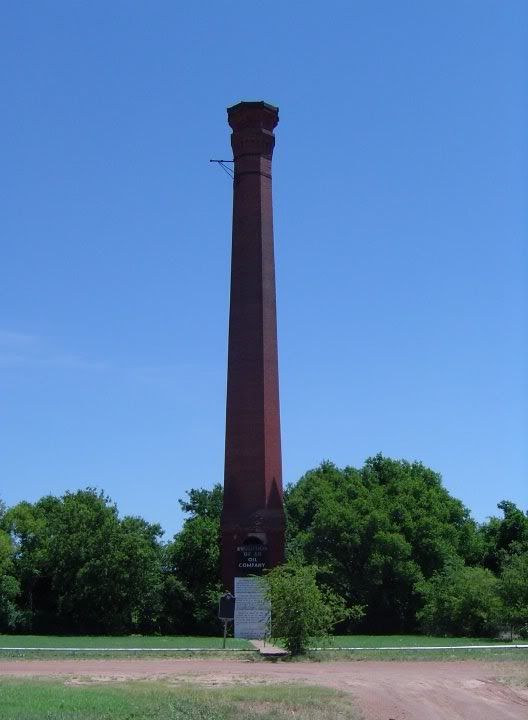
The towering smokestack from the town's former coal-mining industry
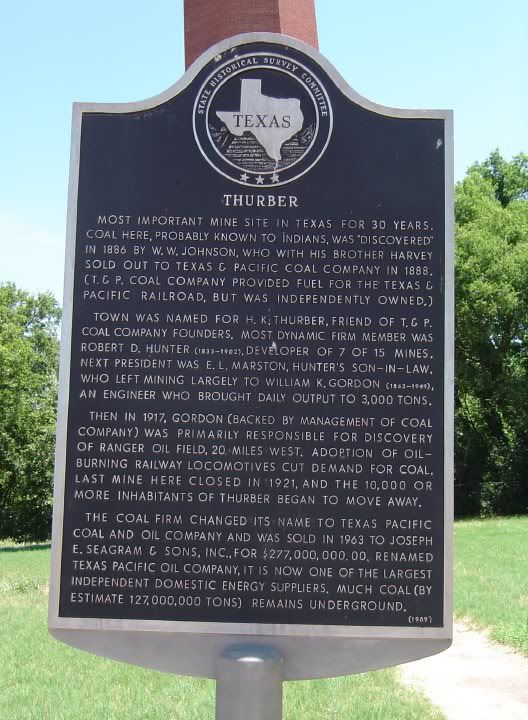
Historical marker in front of the Thurber smokestack
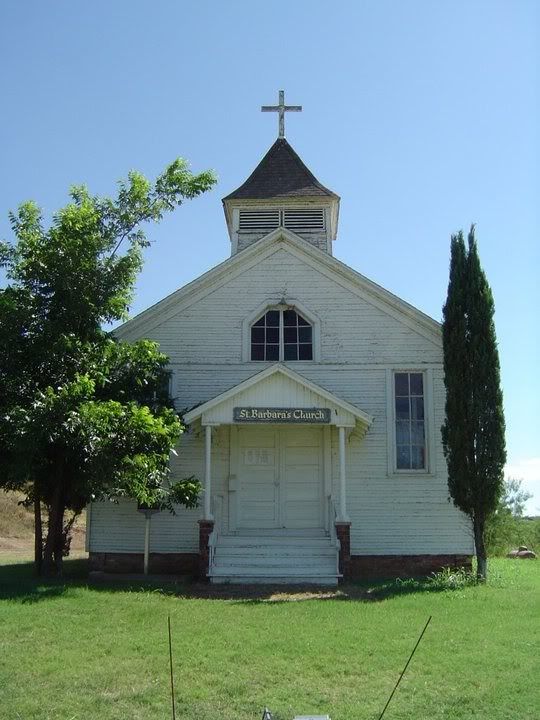
Saint Barbara's Catholic Church, one of the restored buildings
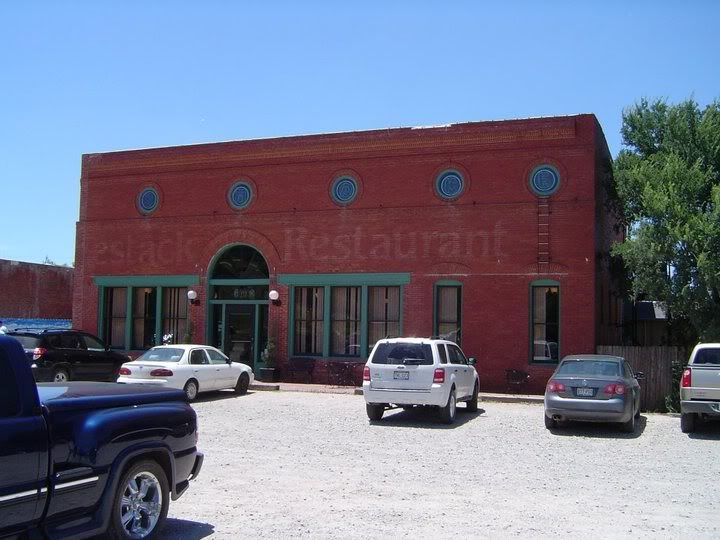
The former company store, now housing one of two restaurants at the townsite

The front gate to Thurber Cemetery, still bearing the Texas Pacific logo
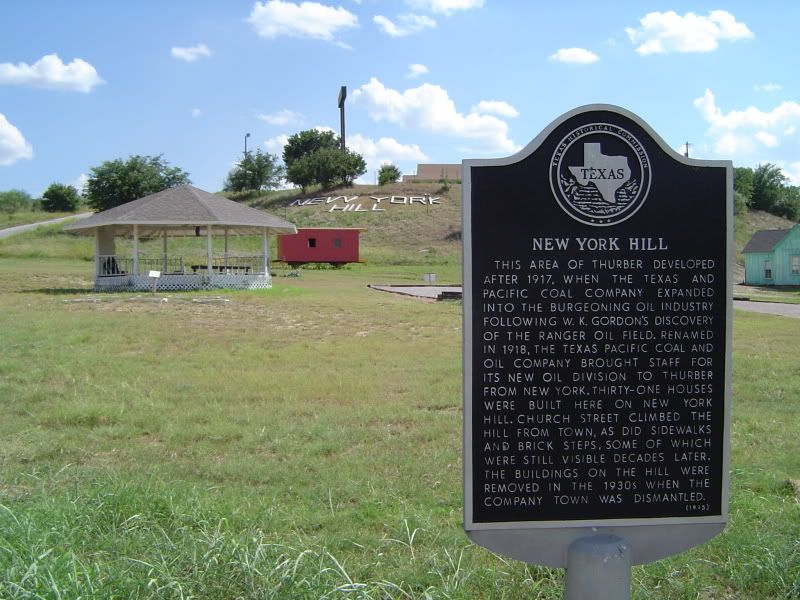
Historical marker and view of New York Hill, which was the neighborhood where Thurber's white-collar workers lived
There is much more to the story of Thurber than I can do justice here, but sitting on the townsite is a wonderful little museum called the W.K. Gordon Center for Industrial History of Texas, complete with relics from Thurber, interactive dioramas, and the recollections of some of the miners who worked at Thurber. The Center is definitely worth squeezing into your Thurber itinerary.
I hope you enjoyed these photos of Thurber along with the short essay. More towns (and photos) to come soon!
Our younger readers may be stumped by the phrase "company town." This means that the town itself was the private property of a company - in this case, the Texas Pacific Coal & Oil Company. If you were a coal miner in Thurber, this meant that the company owned your humble house as well as the land that it sat on. When you got paid, the company didn't pay you in cash; you got handed a wad of company scrip, which could only be spent at the company store, which meant that the company essentially controlled what goods you could purchase. On the flip side, the company store tried to cover all your basic needs from cradle to grave; it sold food, clothing, housewares, baby carriages, and even the coffin in which you could be buried at the company cemetery. (And yes, there is a company cemetery at Thurber to this very day.)
In 1903, Thurber was also the first town in Texas to become a complete "closed shop," which means, for those of you in "right-to-work" states, that if you wanted to mine coal in Thurber, you had to join the union. The town reached a peak population of around 10,000, with Thurber coal and Thurber bricks in great demand throughout Texas and across America.
So what happened to Thurber? Oil happened, that's what. A growing number of locomotives started using oil instead of coal as fuel. Eventually, the Texas Pacific Coal and Oil Company shut down all mining operations at Thurber, putting thousands of hard-working coal miners out of a job by the end of 1921. The brick industry carried on for a little while longer, but the town quickly declined, and by the time America entered World War II, Thurber was a ghost town.
Fortunately, remnants of Thurber were preserved and even restored by some of the diehards who stayed behind, and during two separate expeditions in June and August of 2010, this is a sample of what I found:

The towering smokestack from the town's former coal-mining industry

Historical marker in front of the Thurber smokestack

Saint Barbara's Catholic Church, one of the restored buildings

The former company store, now housing one of two restaurants at the townsite

The front gate to Thurber Cemetery, still bearing the Texas Pacific logo

Historical marker and view of New York Hill, which was the neighborhood where Thurber's white-collar workers lived
There is much more to the story of Thurber than I can do justice here, but sitting on the townsite is a wonderful little museum called the W.K. Gordon Center for Industrial History of Texas, complete with relics from Thurber, interactive dioramas, and the recollections of some of the miners who worked at Thurber. The Center is definitely worth squeezing into your Thurber itinerary.
I hope you enjoyed these photos of Thurber along with the short essay. More towns (and photos) to come soon!
Thursday, August 25, 2011
Submerged ghost town of Towash at Lake Whitney - LAKE LEVEL UPDATE
You may not have heard of the ghost town of Towash, and you'll have a lot of difficulty finding it on even the most detailed of county maps - and for good reason. The entire site of Towash is submerged beneath the waters of Lake Whitney, approximately 15 miles west of Hillsboro in Hill County.
From the Texas State Historical Association website:
Prominent among the newly arrived settlers were brothers Simpson Cash Dyer and James Harrison Dyer, who in 1854 received permission from state authorities to construct a stone dam on the Brazos River at Towash to power a gristmill. In 1860 the Dyers added a wool-carding machine to their water-driven industrial plant. During the early years of the Civil War, women reportedly traveled from as far as 100 miles away to have wool carded at Towash for use in clothing and blankets for Confederate soldiers. A flood destroyed the dam in 1863, but it apparently was rebuilt and a cotton gin established by 1866, the year in which a local post office began operating. This post office closed in 1881, reopened in 1899, and closed permanently two years later. Between 1860 and 1870 Towash had a number of stores and wagonyards, a blacksmith shop, and a ferryboat system.
When the Army Corps of Engineers constructed Lake Whitney in 1951, the remains of Towash (which was prone to the occasional catastrophic flood) were completely inundated, and remain so to this very day.
Well, sort of.
According to the US Geological Survey, as of 8:15pm CDT on Thursday, August 25, 2011, the water levels at Lake Whitney have dropped to 518.22 feet above sea level. Normal elevation for Lake Whitney is 533 feet, indicating that the 2011 drought in Texas has dropped the elevation of Lake Whitney by some 15 feet overall. The drought is obviously hurting the lakeside communities and businesses in the area - but from my own brief explorations of the Lake Whitney shores, it appears to be uncovering a few of the ruins from the townsite of Towash. Photos will be made available soon.
If you have any desire to visit Lake Whitney in order to seek out the remnants of Towash, now is the time. The current water levels at Lake Whitney are the lowest they have been in decades, and are not expected to remain this low for much longer. Just remember the basics: stay hydrated, dress sensibly, don't trespass, and take lots of photos. This is a once-in-a-lifetime opportunity to rediscover a vanished piece of Texas history.
From the Texas State Historical Association website:
Prominent among the newly arrived settlers were brothers Simpson Cash Dyer and James Harrison Dyer, who in 1854 received permission from state authorities to construct a stone dam on the Brazos River at Towash to power a gristmill. In 1860 the Dyers added a wool-carding machine to their water-driven industrial plant. During the early years of the Civil War, women reportedly traveled from as far as 100 miles away to have wool carded at Towash for use in clothing and blankets for Confederate soldiers. A flood destroyed the dam in 1863, but it apparently was rebuilt and a cotton gin established by 1866, the year in which a local post office began operating. This post office closed in 1881, reopened in 1899, and closed permanently two years later. Between 1860 and 1870 Towash had a number of stores and wagonyards, a blacksmith shop, and a ferryboat system.
When the Army Corps of Engineers constructed Lake Whitney in 1951, the remains of Towash (which was prone to the occasional catastrophic flood) were completely inundated, and remain so to this very day.
Well, sort of.
According to the US Geological Survey, as of 8:15pm CDT on Thursday, August 25, 2011, the water levels at Lake Whitney have dropped to 518.22 feet above sea level. Normal elevation for Lake Whitney is 533 feet, indicating that the 2011 drought in Texas has dropped the elevation of Lake Whitney by some 15 feet overall. The drought is obviously hurting the lakeside communities and businesses in the area - but from my own brief explorations of the Lake Whitney shores, it appears to be uncovering a few of the ruins from the townsite of Towash. Photos will be made available soon.
If you have any desire to visit Lake Whitney in order to seek out the remnants of Towash, now is the time. The current water levels at Lake Whitney are the lowest they have been in decades, and are not expected to remain this low for much longer. Just remember the basics: stay hydrated, dress sensibly, don't trespass, and take lots of photos. This is a once-in-a-lifetime opportunity to rediscover a vanished piece of Texas history.
Six headstones vandalized at Clara Cemetery
I can't say I'm all that familiar with the Wichita County ghost town of Clara, but this report from TimesRecordNews.com still saddens me all the same. I have seen many tombstones at ghost towns that have crumbled due to neglect, weathering, and all sorts of causes - it's especially tragic when outright vandalism comes into play.
Wednesday, August 24, 2011
Submerged ghost town of Bluffton resurfaces at Lake Buchanan
Due to the ongoing drought that has gripped Texas this summer, the water levels at Lake Buchanan in Burnet County have dropped to such an extent that the remains of the old Bluffton ghost town site are once again visible - and there are even guided tours to explore the ruins!
KENS in San Antonio has the full story on their website, complete with video - definitely worth checking out.
KENS in San Antonio has the full story on their website, complete with video - definitely worth checking out.
Why start a blog about Texas ghost towns?
I've been fascinated with the idea of ghost towns for a very long time. These forgotten communities are reminders of how fragile and how precious our history really is, and considering the multitude of colorful characters who helped turn Texas into what it is today, that says a lot.
My own personal quest to visit and document ghost towns started shortly after the death of my beloved wife, Ginny, in May 2010. You could say that this ongoing mission is a form of therapy. Ginny wasn't so eager to visit ghost towns, herself; she preferred more traditional travel destinations such as Australia, New Orleans, and Las Vegas - which is where Ginny and I got married on April 1, 2000. Not that I don't see the appeal of carrying a footlong frozen mudslide daiquiri from casino to casino on the sidewalk in broad daylight without getting hassled by the cops, mind you, but I also enjoy this, too.
While the images that will appear on this blog may reach some as nothing more than so many crumbling houses and forgotten tombstones, I can honestly say that my encounters with Texas ghost towns have enriched my understanding of the history and culture of the Lone Star State and of the many people who are a part of our state's diverse and fascinating legacy.
I hope you find the contents of this blog to be informative and enjoyable. And if this blog spurs you to start visiting a few ghost towns of your own, more power to you.
My own personal quest to visit and document ghost towns started shortly after the death of my beloved wife, Ginny, in May 2010. You could say that this ongoing mission is a form of therapy. Ginny wasn't so eager to visit ghost towns, herself; she preferred more traditional travel destinations such as Australia, New Orleans, and Las Vegas - which is where Ginny and I got married on April 1, 2000. Not that I don't see the appeal of carrying a footlong frozen mudslide daiquiri from casino to casino on the sidewalk in broad daylight without getting hassled by the cops, mind you, but I also enjoy this, too.
While the images that will appear on this blog may reach some as nothing more than so many crumbling houses and forgotten tombstones, I can honestly say that my encounters with Texas ghost towns have enriched my understanding of the history and culture of the Lone Star State and of the many people who are a part of our state's diverse and fascinating legacy.
I hope you find the contents of this blog to be informative and enjoyable. And if this blog spurs you to start visiting a few ghost towns of your own, more power to you.
Subscribe to:
Posts (Atom)